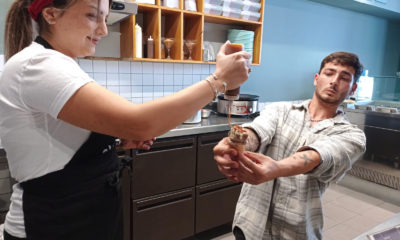
Lifestyle

The low-down on everything culinary in lockdown
I’m aware that not only our lives, but most discussion has been about COVID-19, and it does seem as if it is far from over.
We are still going through a time of uncertainty, financial strain, new work and home environments, continued shopping restrictions, and most important, the need to stay healthy.
Here are some nutritional and culinary tips to keep your body strong, maximise “bang for your buck” when it comes to food purchases, minimise exposure to the grocery store, and avoid wastage.
These tips aren’t only useful and important at this time, but are good to know all the time.
Herbs and spices
These come first as they’re not always on our shopping list of “essentials”. However, when it comes to a nutritional return on investment, herbs and spices contain some of the most concentrated forms of anti-inflammatory and antioxidant agents and are regarded as the cheapest natural supplements.
When researching food sources with the richest content of polyphenol, a naturally occurring chemical which promotes the body to produce its own antioxidants, spices and herbs always come out on top. Raw cocoa, cloves, mint, star anise, coriander, parsley, oregano, rosemary – the works. Fresh ginger, high in gingerol, can also easily be bought and kept in the fridge for a while and offers excellent anti-inflammatory and antioxidant properties.
Don’t forget to add fresh herbs to your shopping list. You can also plant some herbs for a long-lasting supply and a good excuse to get out the house for a bit.
Worried about herbs going off in your fridge? Don’t. Here are some ways to keep them fresher for longer and get the best use out of them:
- Remove them from their original packaging, place them in a re-usable bag with a paper towel and store them in the fridge;
- Chop off the bottom tips of their stems and place them in a jar of water in the fridge, with a bag over their leaves;
- Chop up the herbs, put them into ice-trays with water and freeze. These can then be used later in stews or curries;
- Make a herb oil, pesto, vinegar, or flavoured salt with herbs that aren’t being used; and
- In the oven, dehydrate herbs that aren’t being used, then store in a tight spice bottle.
Fresh versus frozen
Is fresh better than frozen? Although the answer to this is complex, it’s an important one to understand, especially when our aim is to limit shopping time while optimising nutrition.
We have the perception that fresh is always best, but how fresh is fresh? The fruit and vegetables we predominantly purchase at the shops have been picked, washed, or treated, packaged, transported in temperature-controlled vehicles, and stored on shelves in the stores.
Answering our question, though, depends on the product and the nutrient you are looking at. Research shows that frozen food, depending on the cooking technique used after thawing, can often supply a better nutritional landscape than fresh.
Now is a great opportunity to explore how to cook with frozen fruit and vegetables. It’s often more economical too.
Here are some tips when using frozen produce:
- Don’t just pick any bag out of the freezer section. Choose a bag where you can feel the individual pieces as this is a sign they’re still in their original flash-frozen state as opposed to vegetables or fruits that may have thawed and refrozen during distribution;
- Frozen vegetables are usually blanched then flash frozen. This means they have already been partially cooked and must be added to dishes later in the cooking process to avoid overcooking. This is especially important if some ingredients in the dish are fresh as you want them to cook uniformly; and
- To keep your frozen vegetables crisp when roasting, while you heat the oven up, preheat your roasting tray with a drizzle of oil. Make sure to crank up the heat to 230oC so that you release the water immediately and caramelise the vegetables instead of steaming them. Also coat the vegetables with olive oil before throwing them on the roasting tray to ensure a crisp result.
Menu planning
Menu planning as well as a detailed shopping list has never been more important. The goals are to increase variety, spend as little time as possible in the shops, spend wisely, and reduce wastage. A simple menu plan as well as a very detailed shopping list, in the same order that the food products are found in the shops, will help you greatly.
Get creative
Maximise the use of your vegetable or fruit. Use the leaves of your root vegetables, such as beetroot, in smoothies, soups, pesto, or stir-fries. Once you have juiced your lime or lemon, zest them, and freeze the zest to use it to flavour your food when don’t have lemons or limes around.
There should be no concern about produce going off in your fridge. Get your creative caps on. How many different dishes can you make with one left-over ingredient? A simple carrot can be used to make carrot and turmeric soup, carrot chips in the oven, spiced carrot humus, carrot gnocchi, carrot spiralled pasta, carrot cake, or carrot and date energy balls!
Now is the time to see what meal you can pull together with the odds and ends of your fresh, frozen, or tinned produce at home. Think of a vegetable frittata; lentil coconut curry soup; chickpea stir-fry with rice; cabbage leaves stuffed with frozen mince, tinned tomato and rice; or a frozen pea, white bean, and artichoke dip.
Let’s cook like we’ve never cooked before!
- Hilit Milner is a registered clinical dietitian who runs a private practice, works in a top private hospital, and has founded a wellness blog called ‘Sunrise by HM’. She views health holistically, starting from a cellular level and working her way out.










